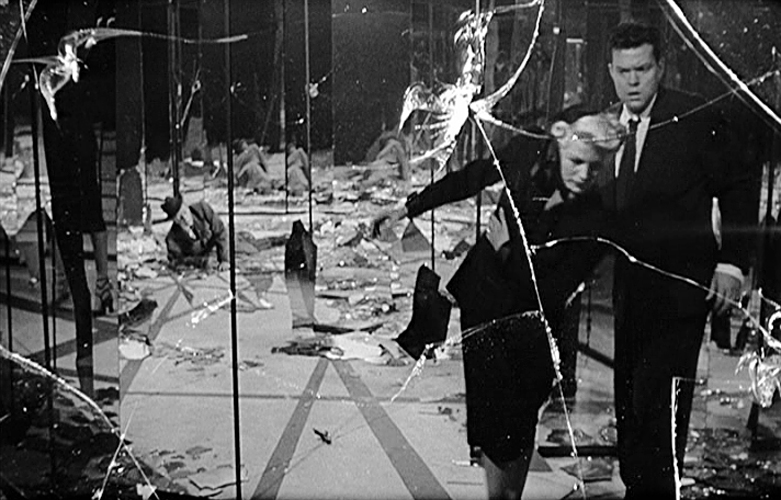One of the most bizarre films of any era is GABRIEL OVER THE WHITE HOUSE, a political fantasy extolling the joys of a totalitarian dictatorship in America! Produced by the independent Walter Wanger , a staunch anti-Fascist(1) , and financed by William Randolph Hearst, the left-leaning newspaper magnate(2) who served as the inspiration for CITIZEN KANE, the film shows what would happen if all the political power in Washington were consolidated in one man – and shows it to be a good thing!
Newsreel footage is interspersed with the inauguration of President Judson Hammond (Walter Huston ), newly elected at the height of the Depression. Hammond is a typically phony, glad-handing politician, more concerned in towing the party line and maintaining the status quo than helping the people that elected him. Though he promises peace and prosperity, Hammond tells the press he regards the problems of unemployment, homelessness, and rampant crime as “a local problem”. He’s more interested in playing with his little nephew (Dickie Moore ) in the Oval Office than listening to a radio appeal from John Bronson (David Landau), leader of the “army of the unemployed”, to meet and discuss the Nation’s troubles. Hammond, like most politicians, just doesn’t care – the bachelor president’s idea of job creation is giving his ‘side piece’ Pendie Malloy (Karen Morley ) the position of personal secretary.
The bubbleheaded Hammond also gets his kicks driving at high speeds, which results in a car crash that puts the president in a coma. Doctors say in private he’s “beyond any human help” – and that’s when a breeze wafts through an open window, and Hammond is bathed in a white light, the implication being a visitation from a Higher Power. Hammond comes out of the coma a changed man, no longer just another party hack, but a man determined to serve the people. He fires his entire Deep State Cabinet and meets with the unemployed “forgotten men”, taking his message directly to the people, calling for the creation of a Construction Army that puts everyone to work on infrastructure. An outraged Congress screams for his impeachment, leading him to disband that cesspool of do-nothings and use the power of the Presidency to declare martial law, making himself Supreme Leader of the country!
Hammond goes into action, putting a moratorium on housing foreclosures, changing the nation’s banking laws, giving direct aid to agriculture, and repealing the 18th Amendment, opening government liquor stores throughout the land. This doesn’t sit well with the criminal element, putting their bootlegging operations out of business, and the crime lord Nick Diamond (C. Henry Gordon ) retaliates by not only bombing the stores, but a drive-by at the White House that injures Pendie! Hammond creates a Federal Police Force, led by his Press Secretary Beek Beekman (Franchot Tone ), who use armored tanks and machine guns to obliterate the gangsters, then sentences them to death at a military tribunal, executing the enemies of the state by firing squad!
In his last master stroke, Hammond decides to pull America out of her financial doldrums by making Europe and the rest of the world pay their war debts by threat of force, gathering the heads of state on his yacht for a grand showing of America’s military might, and calling for worldwide disarmament. The nations of the world agree to his terms, and they all sign Hammond’s “Washington Covenant”, fulfilling his earlier promise of peace and prosperity. The president collapses during the signing, and once again that eerie wind blows through the window as Judson Hammond expires, his job complete.

GABRIEL OVER THE WHITE HOUSE was directed by Gregory LaCava , who headed Hearst’s animation studio Independent Film Services from 1915-18 before moving to live-action two-reelers and eventually full features. Most of LaCava’s films are comedies with social commentary thrown in, like FIFTH AVENUE GIRL, STAGE DOOR, and his most famous movie, MY MAN GODFREY. Here, his direction takes things seriously, though I can’t help but believe, knowing LaCava’s own political views, that there’s more than a touch of satire involved.


This excursion into fascist fantasy was written by Carey Wilson, who would later produce and narrate propaganda films for the war effort and the Department of Defense. Hearst himself is rumored to have penned some of Hammond’s speeches (3), inputting his own political philosophies into the narrative. The real newly elected president, Franklin Delano Roosevelt, watched and enjoyed the film, stating “it would do a lot of good” (4), and actually incorporated some of Hammond’s political ideas into his New Deal. Hearst was a steadfast Roosevelt supporter until disagreements regarding FDR’s vetoing of the Bonus Bill (which would’ve supplied extra aid to WWI vets) and support for joining the World Court (5), coupled with Hearst’s continued fawning over Adolf Hitler, caused a political rift that never healed.
MGM boss Louis B. Mayer hated GABRIEL OVER THE WHITE HOUSE, and wanted to lock it up and throw away the key after sitting through a preview (6). But all the fuss and furor some critics have over this film is meaningless; after all, this is America, Land of the Free and Home of the Brave, right? A political dictatorship? It could never happen here… or could it? COULD IT?
Sources
(1) Hollywood Renegade Archives (website)
(2) William Randolph Hearst: His Role in American Progressivism (Ray Everett Littlefield III, University Press 1980)
(3) The Hollywood Movie Made For FDR’s Inauguration (Richard Brody, The New Yorker)
(4) The Hollywood Hit Movie That Urged FDR to Become a Fascist (Jeff Greenfield, Politico, 3/25/18)
(5) The Chief: The Life of William Randolph Hearst (David Nasaw, Houghton Mifflin 2000)
(6) The Dame in the Kimono: Hollywood, Censorship, and the Production Code (Leonard J. Leff and Jerald Simmons, University Press of Kentucky 2001)





Reblogged this on Through the Shattered Lens.
LikeLike
Wow, I’ve never heard of this film, and now I can’t wait to find and see it. Thanks for a great review.
LikeLiked by 1 person